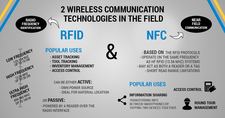Today RFID and NFC are known as modern technologies. Maybe you have a smartphone with NFC. But what does this mean? This blog post will answer a few questions about RFID and NFC technology and will show the differences between both.
RFID and NFC are global wireless or rather contactless communication technologies.
RFID stands for Radio-Frequency Identification. RFID technology enables the communication between an unpowered tag and a powered reader.
RFID systems consist of a reader with an antenna, and a transponder (tag). There are two different RFID tags possible. Either they are active, meaning they have their own power source or they are passive. Passive tags have no own power source and have to be supplied with energy via an electromagnetic field produced by the reader.
Passive transponders or tags are available in three different RFID frequency ranges: Low frequency (LF), high frequency (HF) and ultra high frequency (UHF). The reading range of LF and HF systems is usually only a few centimeters. UHF tags, however, are often readable over distances of more than one meter.
RFID is best suited for asset tracking and location in logistic functions.
NFC stands for Near-Field Communication. NFC is also based on the RFID protocols. The main difference to RFID is that a NFC device can act not only as a reader, but also as a tag (card emulation mode). In peer-to-peer mode, it is also possible to transfer information between two NFC devices.
NFC systems operate on the same frequency as HF RFID (13.56 MHz) systems. Therefore, there are only short read range limitations.
Because of the short read range limitations, NFC devices have to be in very close proximity - usually no more than a few centimeters. That's why NFC is often used for secure communications, especially for access controls or in the consumer sector for contactless payment.
